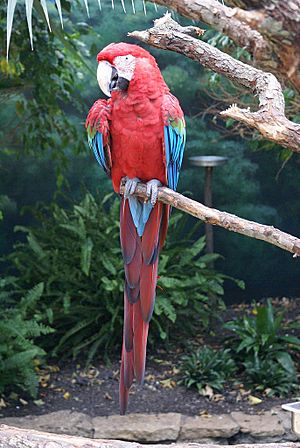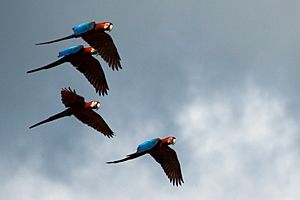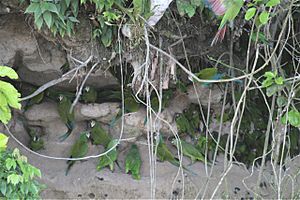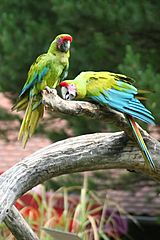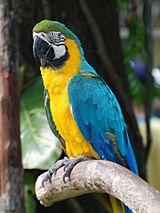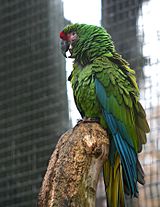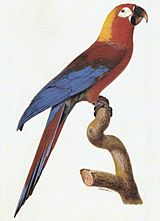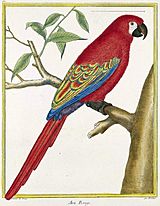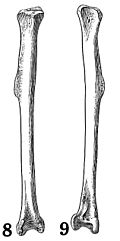Ara (bird) facts for kids
Quick facts for kids Ara (bird) |
|
|---|---|
 |
|
| Blue-and-yellow macaw (left) and green-winged macaw (right) at Jurong Bird Park, Singapore | |
| Scientific classification |
|
| Kingdom: | Animalia |
| Phylum: | Chordata |
| Class: | Aves |
| Order: | Psittaciformes |
| Family: | Psittacidae |
| Tribe: | Arini |
| Genus: | Ara Lacépède, 1799 |
| Species | |
|
See text |
|
Ara is a group of large, colorful macaws found in Central and South America. These amazing birds are known for their long tails, long, narrow wings, and bright feathers. They all have a special bare patch of skin around their eyes. Male and female macaws look very similar.
The name Ara comes from the Tupi language word ará, which sounds like the noise a macaw makes. Many Ara macaws are popular as pets. Sadly, some people illegally catch and sell these birds, which is dangerous for several species and their future.
Contents
What is the Ara Genus?
The group of birds called Ara was first named by a French scientist, Bernard Germain de Lacépède, in 1799. The most famous bird in this group is the scarlet macaw (Ara macao).
For a long time, the Ara group included many different kinds of macaws. But scientists later decided to split them into three new groups: Orthopsittaca, Primolius, and Diopsittaca. The Orthopsittaca and Diopsittaca groups each have only one type of macaw, and they look and act differently. The three macaws in the Primolius group are smaller and mostly green.
Today, there are eight types of Ara macaws still living. Two other types have become extinct in recent times. One more extinct type is only known from old bones found in the ground. The last time someone saw an extinct Cuban macaw was in 1864. We still have some of their skins in museums, but no eggs.
Scientists have also thought about other types of Ara macaws that might have lived long ago but are now extinct. However, there isn't much proof for these "hypothetical" species. They might have been unique birds, or perhaps they were just regular parrots brought to an island and later thought to be a new kind.
How Do Ara Macaws Look?
Ara macaws are big parrots. They can be from about 46 to 95 centimeters (18 to 37 inches) long. Their weight can range from about 285 grams (10 ounces) for the chestnut-fronted macaw to about 1708 grams (60 ounces) for the green-winged macaw.
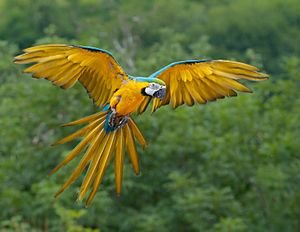
These macaws have long, narrow wings. This shape helps them fly long distances to find food. They also have a very strong, curved upper beak. Around their eyes, they have a patch of pale skin that reaches down to their beak. This skin patch usually has tiny feathers arranged in lines, except for the scarlet macaw, which has completely bare skin there. Most Ara macaws have black beaks. But the scarlet macaw and green-winged macaw have a mostly light-colored upper beak and a black lower beak.
The feathers of Ara macaws are incredibly colorful! Four species are mostly green. Two species are mostly blue and yellow. Three species, including the extinct Cuban macaw, are mostly red. Male and female macaws have the same colors. Young macaws look similar to adults, but their colors might be a little less bright.
Where Do Ara Macaws Live?
Ara macaws live in a wide area from Mexico all the way down to Argentina. The largest number of Ara species live in the Amazon Basin and near the border of Panama and Colombia. In some places, you can find as many as four or even five different Ara species living together.
The scarlet macaw is found in many parts of Central America and the Amazon. However, some species, like the blue-throated macaw and the red-fronted macaw, live in very small areas in Bolivia. Sadly, the places where many Ara species live have become smaller over time because of human activities. For example, the blue-and-yellow macaw disappeared from Trinidad in the 1960s. Several species also became extinct on the islands of the Caribbean.
Ara macaws can live in different kinds of places. The scarlet macaw, for example, can live in humid rainforests, open woodlands, and even savannahs. The most important thing they need is enough large trees. These trees provide them with food and places to build their nests. Other Ara species are a bit pickier about their homes, but they all need big trees. The blue-throated macaw often lives in "forest islands" within the savanna. The red-fronted macaw prefers dry areas with shrubs and cactus plants.
These birds might travel around their home area during different seasons to find food. They don't fly long distances like migrating birds, but they do move locally between different habitats.
What Do Ara Macaws Eat?
Like all macaws and most parrots, Ara macaws mainly eat seeds and fruit. The exact types of food they eat depend on the specific species. Unlike many birds that help spread seeds, macaws are "seed predators." This means they use their incredibly strong beaks to crack open even the hardest shells and eat the seeds inside.
Their diet sometimes overlaps with what some monkeys eat. In one study, green-winged macaws in Venezuela ate seeds from many of the same trees as bearded sakis (a type of monkey). However, the macaws often ate the seeds when they were less ripe and contained more natural poisons. Macaws, like other parrots, sometimes eat clay. Scientists think they do this to help their bodies absorb or get rid of toxic things found in some of the foods they eat. Also, some harmful compounds in food might be made harmless by other things they eat at the same time, like tannins.
How Do Ara Macaws Reproduce?
Almost all parrots, including Ara macaws, build their nests in holes or cavities. Most species nest in holes found in trees, whether the trees are alive or dead. They might use natural holes or holes made by other animals. For example, in Mexico, military macaws still use holes made by the now very rare imperial woodpecker.
Besides nesting in trees, the military macaw and green-winged macaw also nest in natural cracks in cliffs. This is the only way the red-fronted macaws can nest, because there aren't enough large trees in their dry habitat.
Species of Ara Macaws
| Ara | |||
|---|---|---|---|
| Common and binomial names | Image | Description | Range |
| Great green macaw or Buffon's macaw (Ara ambiguus) |
85–90 cm (33–36 in) long. Mostly green, red on forehead, green and blue wings | Central and South America, from Honduras to Ecuador | |
| Blue-and-yellow macaw or blue-and-gold macaw (Ara ararauna) |
80–90 cm (31.5–35.5 in) long. Mostly blue back and yellow front. Blue chin and green forehead. The upper zone of the bare white skin around each eye extending to the beak is patterned by lines of small dark feathers. | Panama, Colombia through to south-central Brazil. | |
| Green-winged macaw or red-and-green macaw (Ara chloroptera) |
90 cm (36 in) long. Mostly red, with blue and green wings. The bare white skin around each eye extending to the bill is patterned by lines of small red feathers. | South America, from Colombia through to northern Paraguay (formerly northern Argentina) | |
| Blue-throated macaw (Ara glaucogularis) |
75–85 cm (30–34 in) long. Blue upperparts and mostly yellow lowerparts, blue throat. Areas of pale skin on the sides of the face are covered with lines of small dark-blue feathers, with pinkish bare skin at the base of the beak. | North Bolivia | |
| Scarlet macaw (Ara macao) |
81–96 cm (32–36 in) long. Mostly bright red, with red, yellow and blue in the wings. There is bare white skin around the each eye extending to the bill. | Mexico to Colombia and the Amazon Basin. | |
| Military macaw (Ara militaris) |
70 cm (28 in) long. Mostly green, red forehead | Discontinuous distribution in Mexico and along the Andes from Venezuela to north Argentina. | |
| Red-fronted macaw (Ara rubrogenys) |
55–60 cm (21.5–23.5 in) long. Mostly green. red forehead and red patch over the ears, pinkish skin on the face, red at bend of wings, blue primary wing feathers | Central Bolivia | |
| Chestnut-fronted macaw or severe macaw (Ara severa) |
46 cm (18 in) long. Mostly green, chestnut forehead, red at bend of wings | Panama and South America in the Chocó and Amazon Basin | |
| †Cuban macaw (Ara tricolor) Extinct ca. 1885 |
50 cm (20 in) long. Red forehead fading to orange and then to yellow at the nape of the neck, dark brown bill paler at the tip; orange face, chin, chest, abdomen and thighs; upper back mainly brownish red, and the rump and lower back blue; brown, red and purplish-blue wing feathers; upper surface of the tail was dark red fading to blue at the tip, and brownish red underneath. | Extinct - formerly endemic on Cuba and probably also on Isla de la Juventud (previously called the Isle of Pines). | |
| †Lesser Antillean macaw or Guadeloupe macaw (Ara guadeloupensis) Hypothetical, extinct |
Not known if it existed. Tail feathers 15–20 inches long. Similar colour as the scarlet macaw, but smaller with an entirely red tail. Known from descriptions and possibly paintings and subfossils. | Hypothetical, extinct - Guadeloupe | |
| †St. Croix macaw (Ara autocthones) Extinct |
Only known from sub-fossil bones found at two archeological sites. | Extinct - Saint Croix, U.S. Virgin Islands and central Puerto Rico | |
Extinct Ara Macaws: What We Know
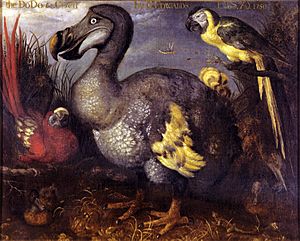
Macaws were moved between the Caribbean islands and from South America a long time ago, both by Europeans and by ancient people called Paleoamericans. Parrots were very important to the culture of the native Caribbean people. They traded birds between islands, and even gave them as gifts to Christopher Columbus when he arrived in the Bahamas in 1492.
Because of this, it's hard to know if old stories about macaws on these islands were about unique species that lived only there, or if they were just pet macaws that escaped and started living in the wild. Some people have suggested that as many as thirteen different types of extinct macaws once lived on these islands.
However, we only have physical proof (like bones or museum skins) for three extinct Caribbean Ara macaw species:
- The Cuban macaw (Ara tricolor) is known from nineteen museum skins and old bones.
- The Saint Croix macaw (Ara autochthones) is only known from old bones.
- The Lesser Antillean macaw (Ara guadeloupensis) is known from old bones and written reports.
Sadly, no unique Caribbean macaws are left today. Humans likely caused them all to become extinct, some in recent history and others long ago.
Besides these three, some other "hypothetical" extinct Ara macaws were only based on old stories. Many scientists today doubt if these birds truly existed. Many of these names were given by Walter Rothschild in the early 1900s, who sometimes named species with very little proof. For example, the red-headed macaw (Ara erythrocephala) and Jamaican red macaw (Ara gossei) were named from stories about macaws in Jamaica. The Martinique macaw (Ara martinicus) was from Martinique, and the Dominican green-and-yellow macaw (Ara atwoodi) was thought to come from Dominica.
Other species have also been mentioned, but many never got official scientific names, or are now thought to be the same as other known species. Scientists are still trying to figure out the true identity and locations of these native Caribbean macaws. They hope to learn more through finding old bones and studying historical reports and artwork.
| Hypothetical Extinct Species | |||
|---|---|---|---|
| Common and Scientific Names | Image | Description | Where They Lived |
| †Jamaican Green-and-yellow macaw or red-headed green macaw (Ara erythrocephala) Extinct |
 |
We don't know its exact length. It had a red head, a bright green body, and blue wings with blue feathers on top. Its tail and wings were intense orange-yellow underneath. | Jamaica |
| †Jamaican red macaw or Gosse's macaw (Ara gossei) Extinct |
 |
We don't know its exact length. It was similar to the Cuban red macaw, but it had a yellow forehead. | Jamaica |
| †Martinique macaw (Ara martinicus) Extinct |
 |
We don't know its exact length. It was blue with an orange-yellow chest. | Martinique |
| †Dominican green-and-yellow macaw (Ara atwoodi) Extinct |
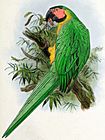 |
We don't know its exact length. It was green, yellow, and red. | Dominica |
See also
 In Spanish: Guacamayos para niños
In Spanish: Guacamayos para niños


